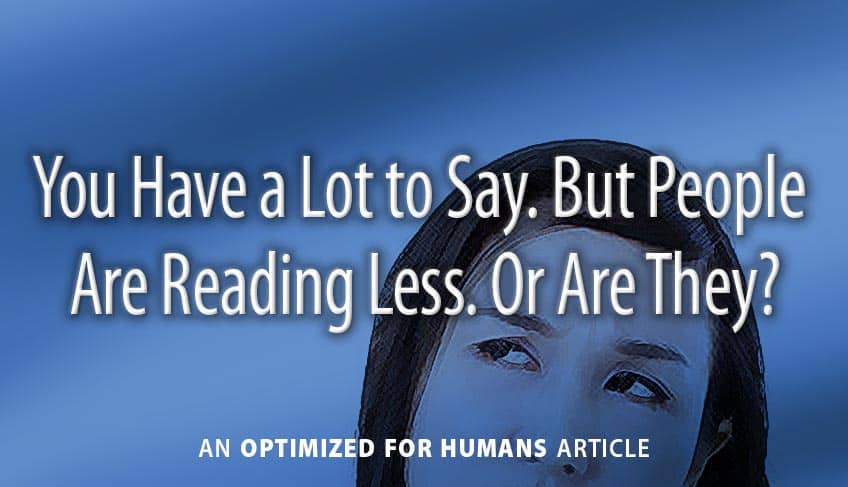
B Y T O M T O R T O R I C I
If you’re having trouble getting your message to stand out from the clutter, you’re not alone. One research company has estimated a current worldwide total of 45 zettabytes of digital data floating around out there. How much is a zettabyte? Honestly, I don’t even know. But I read that it works out to one website for every four humans.
At the same time, our attention spans aren’t getting any longer. Zipping through our days, we get frustrated with any web page we can’t quickly and easily scan.
Many website creators have caught on to the idea of intentionally writing and designing pages specifically for scanners (approximately 100% of us). But many others still pursue the hopeful fantasy that readers will happily read every word of their wordy website, in the intended sequence.
If you’re trying to sell something or attract leads on your website, the smartest strategy appears to be what I’ll call content layering. It’s based on creating pages that reflect the stages that a typical buyer goes through in the course of their decision-making. And no, I don’t claim to have invented the standard branching structure of websites. I just gave it a name.
Starting at Home
We’ve all seen dense, text-heavy Home pages that make us lurch for the Back button. More recently, though, we’ve also seen image-heavy pages competing to reduce text to as close to none as possible. People love visuals, right?
Right, but they generally spend a fraction of a second on them before glancing around for something that helps solve the issue that triggered their search. When it takes 15 seconds to consume an entire page’s content, this signals a lack of visitor engagement to Google, who then punishes the page in rankings.
Did you happen to read about recent changes to Google’s algorithms? They now add significantly more weight to engagement factors such as page ‘dwell time’. ‘Nuff said.
Our challenge, then is to find a compromise that avoids the two extremes. These days, that usually means a sequence of brief messages, each most often a header, one or two sentences of supporting text, and perhaps a link.
Leaving Home
Let’s think of our Home page as an ‘intro’ for first time visitors and people in the early stage of the buying process. The purpose here is to present a series of fairly brief but intriguing messages that make people curious enough to click on the accompanying links to our topic pages.
Now that we’ve drawn their interest, we can get away with more text here than we could on our home page. But we still don’t want to overwhelm their fragile attention spans.
Once again, the purpose is to include irresistible appeals to get ‘em to click on links to whichever sub-topic pages they personally might find interesting. And of course Google is growing more impressed with each and every click.
Far From Home
If our reader has dug this deep, then we have their attention in our pocket, and can get away with larger chunks of running text. Here, we find the popular belief that “people don’t read” significantly less true. People read what they want to read.
And typically, people want to read truly relevant, useful (and at least somewhat entertaining) info that’s well-written and carefully thought-through. It also needs to be broken up with section headers and other elements to make it eye-freindly.
Also, as it turns out, these longer sub-topic pages offer opportunities for long-tail keywords that the site has a good chance of ranking for. After all, it’s tricky to insert a four-word keyword phrase several times in a page with just 50 words, without turning it into an awkward keyword salad.
Plan Your Layers
Content layering starts with the web copywriter who carefully divides the content into three successive layers, then sub-divides it into pages and blocks. Smart designers know how to visually present that content in ways that draw people in rather than scare them away.
This approach might inevitably result in some text repetition between layers, but that’s actually a good thing, not a bad thing. People are far more likely to remember a ‘main idea’ or USP that they’ve heard several times, vs. the many, many points on a site that are only made once.
I’ve learned most of what I know by paying close attention to my attention when my eye first lands on a web page (and other types of media). By consistently doing the same yourself, I’m confident that you will learn more than you ever could by reading my blog posts.
Do you have a lot to say, and actually want people to read it? I get it, and I can help. Learn more about how I help you engage your audience.
Share It:
 About the Author: Tom Tortorici is an Atlanta copywriter and web content writer who helps companies make a genuine connection with their audience. His classes and conference presentations have focused on how writing, strategy and design can work together to grab attention and interest even among readers with short attention spans. In addition to working directly with businesses, Tom regularly partners with web designers and marketing agencies.
About the Author: Tom Tortorici is an Atlanta copywriter and web content writer who helps companies make a genuine connection with their audience. His classes and conference presentations have focused on how writing, strategy and design can work together to grab attention and interest even among readers with short attention spans. In addition to working directly with businesses, Tom regularly partners with web designers and marketing agencies.
All Posts/Subscribe >
Info for Businesses >
Info for Designers/Agencies >
Tom Tortorici Inc. | Tom@TomTortorici.com | 770-934-7861 | 3101 Rockaway Rd | Atlanta GA 30341
